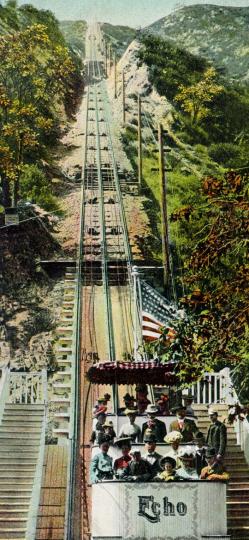 |
An early postcard of The Great Incline |
The Great Incline
By Jake Brouwer
 |
An early postcard of The Great Incline |
When most of us think of the Scenic Mt. Lowe Railway the first thing that comes to mind is the Great Incline. For many of us this is because the Incline is the most depicted feature of the railway in photographs and on souvenirs. For some it is the feature remembered most from first hand experience. Those of you that do remember are among a lucky few today that can relive the experience of the ride up to Echo Mountain.
Some say it was a frightening experience for a timid person. Others marveled at its ingenuity and most were simply awestruck by the beauty that opened up before them as they rose into the sky. The movement of the car was smooth and easy as it rose above the platform at Rubio Station revealing the Rubio amphitheater. The mountains seemed to rise with you at first but at the same time the picture before you increased in size every minute as you rose. When finally you pass the MacPherson trestle, the San Gabriel Valley unfolds its splendor before you and helps to keep your fears at bay of the drop that lies before you and on either side. As you near the top, far down in the valley you can see the serpentine San Gabriel River winding its way to the ocean, Signal Hill at Long Beach, and the Twin Peaks on Catalina Island.
I suppose then that it’s a good thing that you knew nothing of the goings on the in day before your holiday brought you to the Incline railway.
It was around 9:00 AM the prior day that a crew of 13 from the mechanical department and 3 from the electrical department began the task of unloading the tool car at Rubio Station. Their job that day was to change the cable that held and pulled the cars up and down the Incline. Mr. Phelps from W. S. Steel Products came to the incline personally to inspect the cable where 17 to 20 wires were reported to be broken. Phelps stated that this trouble is caused by a single bad and large wire having got into this strand and this wire is taking all the wear and may even be expected to break to an even greater extent. All of the breaks were in the one wire and no other wires were affected except a couple of places where the wire had broken at the braze. So, apparently not a big deal, a new cable was ordered and the work crew set out to replace the new cable. Cutting, splicing, winding and pulling comprised the next 14 hours until the completed cable attached to the cars was run through the winding gear at Echo to take out any possible twists and prevent spinning when the cars are loaded. After three round trips were made with the cable the clamps were all attached to the new cable and at 2:45 AM the cars made the first run up the Incline. By 4:30 AM the job was done and the Scenic Mt. Lowe railway was ready for another day of operation.
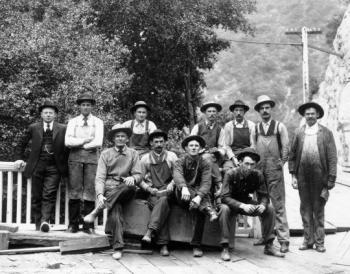 |
A crew of workmen pose for a picture after
completing repairs which were a day to day behind the scenes occurrence. Can you
identify anyone in this picture. If so, please let us know at Land~Sea Discovery Group |
Had one been aware of this activity the night before one might have reconsidered a trip to Echo that day however it was just another day in the life of this Great Incline. In fact it turns out that the cable was replaced nearly every three years as a precaution. In all its years of operation there were no accidents or equipment failures causing injuries thanks to Pacific Electric's inspection policies. J. Haughton and M. Blackmur and their crews throughout their employment for the railway routinely did inspections and repairs on the incline machinery. Reports were kept in logbooks and signed by each respective inspector. These men tested the automatic clutches, hand brakes, and bad slices. Gears, sheaves, and wheels were sounded for possible fractures. Turnbuckles and tension rods were adjusted on the Incline cars. Burned out motors were replaced and old armatures sent off to the Torrance shops for repair. There were many men involved in the after hours, behind the scenes, day to day operations of this Great Incline that MacPherson and Lowe brought to be.
From the day David J. Macpherson met with Professor Thaddeus Lowe unstoppable forces were set into motion that have staggered the imagination of most who attempt to comprehend. From railway offices set up on the second floor of Lowe’s partially refurbished Pasadena Grand Opera House, Macpherson reviewed and studied plans for the railway. Estimates were made and soon crews were put together to start work on the Incline.
The first task was to build a pack trail up to Echo Mountain so supplies could be brought up to the new construction camp. Mules and burros being the main mode of transportation in the mountains. Burros were also used to carry water and cement for building the walls and buttresses where the track would be laid. The grade of the Incline was all done by hand and careful blasting the most difficult part being the mountain ridge later dubbed Granite Gorge. All possible laborers were put to work on this phase of the project. The grade was so precipitous and the slopes so unstable that most of the materials for this phase were carried in on the backs of men. It took eight months to complete the grade through Granite Gorge before a single tie could be laid. The debris had to be carried up the slope 50 feet and then dumped off a side canyon.
The next job to surmount was that of the deep canyon just beyond Granite gorge. Engineer David J. Macpherson designed and built the trestle later named after him. It was 200 feet long and stood 114 feet higher on its upper end. Macpherson Trestle was one of the great engineering wonders of the time. Before it could be completed however, a construction cable had to be elevated into place. A huge manila rope was used to haul the cable up the mountain, drawn by 4 horses hitched to a winch which wound the rope on a spool as the cable was drawn up. It took two hours to bring up the 3000-pound cable.
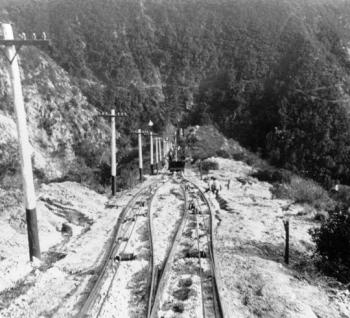 |
A great shot of the turnout on the Great Incline looking down towards Rubio Pavilion |
Ties, trestle timber, spikes, and rails could now be brought up with ease. Tracks were laid on one side at first to bring supplies and building materials up. The tracks consisted of three 20-pound rails, which rested on stringers framed into the ties to prevent creeping. Lowe’s idea of a turnout in the center of the Incline allowing cars to pass was incorporated and a fourth track was laid at the turnout. The tracks were placed 3 ½ feet apart. On January 19, 1893 the Macpherson Trestle was completed and soon after in February the Incline tracks were complete.
The Incline
starts at an elevation of 2200 feet at Rubio Station platform and rises to Echo Mountain,
which is 3500 feet. It is upwards of 3000 feet in length and makes a direct ascent of 1245
feet. The grade begins at 60% (meaning a rise of 60 feet in going 100 feet in elevation)
and continues until after passing the turnout where it takes on an amazing 62% for some
distance. Then it makes two buckles, one to 58% and as it nears the summit it buckles to
48% thus making it the steepest railway in the world at the time.
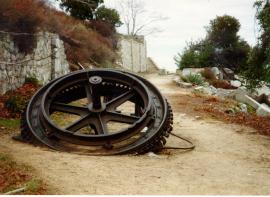 |
The "bullwheel" rests quietly on Echo Mountain, a testament to the engineering skills of men like David Macpherson and Thaddeus Lowe |
The endless permanent cable was installed in March of 1893, being the finest cable built and was tested to withstand to a strain of 100 tons. It was 1¼ inches thick and weighed over 6 tons. At the top of the Incline the traction cable is wound around a driving drum or "bullwheel" three times. At the bottom the cable passes through a horizontal sheave which is carried on a weighted frame and also serves the additional purpose of a tension carriage. A second steel cable 1½ inches thick is employed as a safety cable. The grip for the traction cable is placed beneath the front platform of the car and the safety grip is under the middle of the car. The moment the traction rope is released the safety grip instantly closes on the other cable making a decent impossible. Tests were frequently made to test the safety cable and the cars were expected to stop within two feet. The best manufactured friction brakes and speed regulators were also attached to the machinery controlling the cable should the operator fail to stop the car in the proper place.
|
A view of the Incline from the bottom up |
The cast iron, 9 foot diameter bullwheel had 72 automatic grip sheaves around its circumference which employed 45 at one time to grip the great traction cable greatly reducing wear on the cable. A 100 horsepower motor going 500 revolutions per minute was reduced down by a series of gears and pinons so that by the time it reached the grip sheaves on the bullwheel it was reduced to 13 revolutions per minute. By this means the cars could be pulled up the Incline at approximately 4 miles per hour. It took 6 minutes to complete the ride to the top. Water and electricity powered the motor, kept in the Incline Powerhouse.
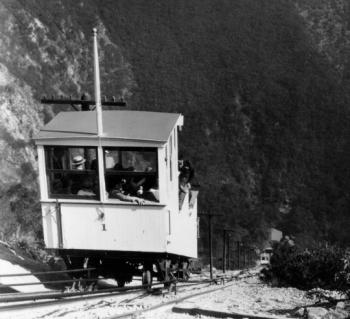 |
A Pacific Electric Car travels down the Incline towards Rubio |
On June 21, 1893 the Incline was operated by electricity for the first time. On July 4, 1893 with much fanfare, the Mt. Lowe railway was officially opened to the public. A few thousand people were on hand to witness the event and many paid the $5.00 fee to ride the rails. The Pasadena City Band was given the honor of the first ride up to Echo Mountain playing "Nearer My god to Thee."
During the next 44 years the Great Incline was to witness the passing of
hundreds of thousands of people over its rails. Tourists, conventioneers, workmen,
chambermaids, cooks, conductors, and tycoons all traveled along the only route possible to
Echo Mountain and points beyond. The Incline not only took people up but also brought up
building materials for all the hotels on Echo and the alpine Tavern. The narrow gauge cars
for the Alpine division were brought up on the trucks of the Incline cars. Gold ore was
shipped from Dawn Station to the Incline and on down to marketplace. On two separate
occasions automobiles were brought up the Incline for publicity purposes.
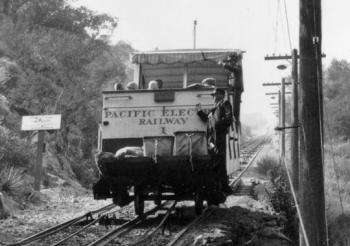
Before its official "Last Run" by the Railroad Boosters on Dec.5, 1937
the Incline also had experienced fire caused by the windstorm of 1905. It helped to pull
Helen Drew to safety after a landslide at Rubio, and had a power line destroy a good part
of Macpherson Trestle, all causing temporary delays of service. The Inclines final days
were in 1940 when a salvage company slowly dismantled what was left.
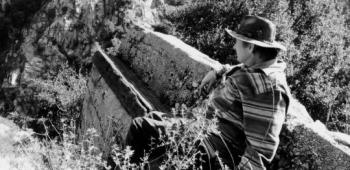 |
A restive Robert Wilde admires the view of the depths of Rubio Canyon from the lower end of Macpherson Trestle |
To end on a happier note perhaps one of the people to whom we can most be
thankful for in remembering the Great Incline of the Scenic Mt. Lowe Railway is Charles
Lawrence, official photographer of the railway. His group photos taken at the top of the
Incline have helped keep the memory alive in thousands of homes across America. Imagine if
you will rummaging through the old trunk in the attic and finding the Incline photo shown
on the cover of this publication. Imagine the memories and discoveries locked within.
Smile.
Send email to Echowebmaster@aaaim.com to report any problems.
Last modified: February 12, 1999
No part of this paper may be
reproduced in any form without written permission from:
Jake Brouwer
All articles and photos were provided by:
Land-Sea Discovery Group
Copyright © 1999